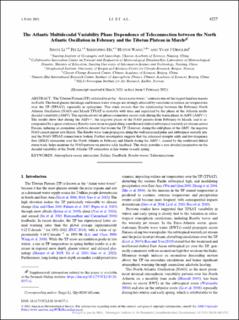The Atlantic Multidecadal Variability phase-dependence of teleconnection between the North Atlantic Oscillation in February and the Tibetan Plateau in March
Journal article, Peer reviewed
Published version

Åpne
Permanent lenke
https://hdl.handle.net/11250/2837978Utgivelsesdato
2021Metadata
Vis full innførselSamlinger
- Geophysical Institute [1198]
- Registrations from Cristin [9791]
Sammendrag
The Tibetan Plateau (TP), referred to as the “Asian water tower,” contains one of the largest land ice masses on Earth. The local glacier shrinkage and frozen-water storage are strongly affected by variations in surface air temperature over the TP (TPSAT), especially in springtime. This study reveals that the relationship between the February North Atlantic Oscillation (NAO) and March TPSAT is unstable with time and regulated by the phase of the Atlantic multidecadal variability (AMV). The significant out-of-phase connection occurs only during the warm phase of AMV (AMV+). The results show that during the AMV+, the negative phase of the NAO persists from February to March, and is accompanied by a quasi-stationary Rossby wave train trapped along a northward-shifted subtropical westerly jet stream across Eurasia, inducing an anomalous adiabatic descent that warms the TP. However, during the cold phase of the AMV, the negative NAO cannot persist into March. The Rossby wave train propagates along the well-separated polar and subtropical westerly jets, and the NAO–TPSAT connection is broken. Further investigation suggests that the enhanced synoptic eddy and low-frequency flow (SELF) interaction over the North Atlantic in February and March during the AMV+, caused by the southward-shifted storm track, helps maintain the NAO pattern via positive eddy feedback. This study provides a new detailed perspective on the decadal variability of the North Atlantic–TP connection in late winter to early spring.